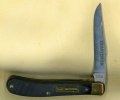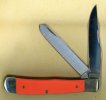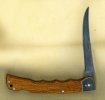First off, I am very protective of the knowledge we share here! I learned, and continue to learn by trying to remain humble before the knowledge. I try not to leap into the limelight, bragging about my accomplishments, until I have done my homework!
I am not afraid of being called a fool, I gladly accept the accolade when it applies, but I am DEATHLY afraid of steering someone wrong.
Humility is always required to learn anything; humility, and the ability to let go of ego.
A lot of terms are being used here that have no basis in fact. Here are a few things that everyone who seriously wants to collect OLD knives must know. It is by no means a complete list, and I always welcome sensible debate.
The finishes;
A Crocus finish IS the mirror polish finish. A fine iron oxide powder is the main ingredient in doing a Crocus finish. Done right, it is like a mirror, with no "orange peel" or wavey reflections. Schrade typically Crocus polished the mark side of the main blade, and often added an etch. The factory finish CANNOT be restored. A blade can be repolished, but then it is YOUR finish, not a factory finish!! Personally, I'd rather have 10% of the factory finish left, than 100% of a new finish! A new finish destroys All of the original character, all of the original design, all of the original cutler's work, and leaves the steel in another form.
Glaze finish: Glaze finish is a non-polished finish, characterized by use of a fine grit, and leaves a striated appearance of fine parallel lines. All the rest of the blade sides on a typical old Schrade knife were done this way. It is way less difficult and expensive (in terms of labor, and materials, than a crocus polish. The lines are typically perpendicular to the blade spine, or main axis. Less expensive knives may have a glaze finish on all faces (often a Boy's jack would be all Glaze).
Again, you do not restore a glaze finish! You refinish the knife, losing the original finish!!
Cleaning a knife should mean rubbing the dirt off of it with an oily soft cloth, and other minimally invasive steps. To my painful regret, it has come to mean ignorant or greedy people polishing the crap out of a knife, and selling it to foolish people.
How many great historical knives have been ruined this way?? I shudder to think!
When you really study the great old cutleries, and their beautiful work, you realize that very few places in the world are capable of achieving the same handcrafted beauty!
Then the next conclusion is, it is a worthy cause to preserve that history, lest we forget what is humanly possible.
















